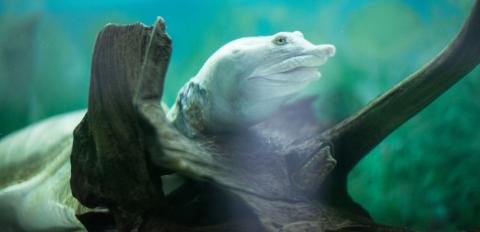Scientists Discover 230-Million-Year-Old Turtle That Had No Shell

Modern turtles are synonymous with the shells that serve as protection from predators, but a recently discovered fossil from close to 230 million years ago suggests that the animals didn’t always have this distinctive feature.
In a study published Wednesday in the journal , researchers detailed a find from Guizhou Province in China, where the fossil of a 6.5-foot-long turtle called Eorhynchochelys sinensis, or “dawn beak turtle from China,” was discovered. While the prehistoric turtle’s skull and toothless beak are similar to that of present-day turtles, the researchers noted that the creature’s skeleton was closer to that of an ancestor that existed some 240 million years ago.
Further describing the prehistoric turtle’s possible appearance, wrote that the creature might have had wide ribs and a “Frisbee-shaped” body, albeit one where the ribs didn’t result in the turtle having a shell like its modern-day counterparts.
“This creature was over six feet long, it had a strange disc-like body and a long tail, and the anterior part of its jaws developed into this strange beak,” explained Field Museum paleontologist Oliver Rieppel, a co-author on the new study.
As pointed out by Nature, the new discovery simultaneously helped scientists determine when modern turtles might have developed a shell, beak, and other recognizable physical features, but also raised a number of unanswered questions regarding the animal’s origins. CNN noted that a 240-million-year-old species called Pappochelys had a “bony structure” over its belly, while Odontochelys, which existed about 20 million years later, already had a shell covering its underside, but not the carapace, or upper shell, that covers the backs of modern turtles.
A two-meter-long fossilized turtle discovered in southwestern China offers evolutionary clues in how the reptiles developed beaks and shells. https://t.co/Uzuqf4Yhws
— Nature News & Comment (@NatureNews) August 23, 2018
According to CNN, E. sinensis is an example of mosaic evolution at work, as it developed a beak before other turtles did, but did not come with a carapace. Mosaic evolution happens when a living creature separately develops certain traits at different times and not necessarily in the order expected.
“This impressively large fossil is a very exciting discovery, giving us another piece in the puzzle of turtle evolution,” said National Museums Scotland researcher and study co-author Nick Fraser.
Interestingly, the researchers’ discovery of a prehistoric turtle without a shell also suggests that early turtles might have been diapsids, putting them in the same reptile family as lizards and snakes. This can be inferred from the two holes on the side of E. sinensis’ skull, which, according to study co-author Rieppel, ends the debate as to whether turtle ancestors are “evolutionarily more advanced” diapsids, rather than anapsids that didn’t have the distinctive holes in their skulls